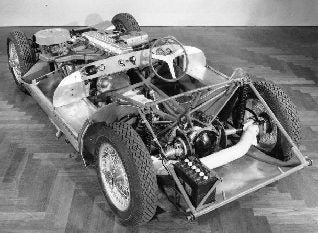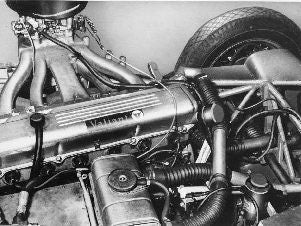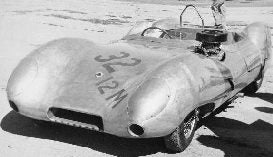The Lotus Valiant
All information on this page was provided by Russell L Shreve
Russell Shreve wrote: This is the Lotus 11B with the first HyperPak dyno test engine. It is the first race car to successfully use the engine as a stressed member of the chassis. Colin Chapman asked me how I made it work, because he had tried it in an early design of his that was a disaster. He used my answer to design the Ford-Indy-Lotus. I would like to find the Lotus-Valiant. Maybe someone out there knows where it is, but has no idea of its history.
| Lotus-Valiant chassis rear left quarter view ith body off. The load path is from the rear suspension points. through the central structure around the transmission, through an aluminum plate between the transmission and engine, through the engine to the front suspension. The differential is a Valiant rear axle I modified to a DeDion arrangement. Gear ratios were changed by exchanging the three differential assemblies, each with a different ratio. After unbolting the half-shafts, the differential assembly detached from the frame by removing three bolts. |
 |
 |
EX-1: The dyno development engine for the HyperPak. Note the Mylar Valiant sticker. |
| Lotus-Valiant at early race before paint. If you wondered where the carburetor went, now you know. This system worked perfectly even at 186 mph! |
 |
| Body | |
| Construction | Aluminum fabrication with light weight, aerodynamic shape |
| Type | Lotus Mark Eleven |
| Frame | Space structure of welded steel tubing and riveted on stressed sheet aluminum; engine used as stressed member to give chassis torsional rigidity. |
| Length | 135 inches |
| Width | 62 inches |
| Height | 27" (at cowl), 33" (at windscreen) |
| Wheelbase | 86 inches |
| Tread | 7 inches |
| Engine | |
| Source | Valiant HyperPak |
| Type | 6-cylinder in-line overhead-valve |
| Bore | 3.41 inches |
| Stroke | 3.125 inches |
| Capacity | 170 cubic inches (2.79 liters) |
| Horsepower | 182 |
| Fuel System | Side-mounted 7 gallon aluminum fuel tank, engine mounted mechanical fuel pump |
| Transmission | |
| Warner T-10 | 4-speed synchromesh |
| Differential | |
| Source | Modified Valiant |
| Mounting | Sprung |
| Ratios | 3.23, 3.55, 3.91:1 |
| Front Suspension | |
| Type | Independent |
| Standard production parts | Knuckles, hubs, steering arms, upper control arms |
| Steering | Rack and pinion |
| Fabricated parts | Anti-roll bar, lower control arms, coil-shock springing |
| Rear Suspension | |
| Type | DeDion: 4-link parallel geometry with right hand lower link triangulated, coil-shock springing |
| Wheels and Tires | |
| Goodyear racing tires | Front 4.5 - 5.0, Rear 5.5 - 5.9 |
| Wheels | 15" Dunlop steel rim and wire spoke with center knock-off mounting; 4.5" width front, 5.5 rear |
| Brakes | |
| Type | Girling 9.125" disk with alloy calipers |
| Front mounting | Wheels |
| Rear mounting | Inboard, at differential |
| Cooling | |
| Radiator | Custom made, high density core, cross flow, separate header tank |
| Weight | |
| Overall | 1406 lb with full tank of gas (7 gallons) |
| Distribution | 45/55 |
| Weight:Horsepower ratio | 8.6 lb/hp |
| Engine | 533 lb |
| Final drive | 73 lb |
| Transmission (w/propshaft, etc) | 104 lb |
| Front suspension | 47 lb |
| Rear suspension | 31 lb |
| Steering | 25 lb |
| Wheels and tires, incl spare | 152 lb |
| Brakes | 60 lb |
| Electrical | 38 lb including battery, wiring, instruments, controls |
| Cooling | 23 lb |
| Chassis | 24 lb including exhaust, fuel system, clutch |
| Frame | 106 lb steel, 40 lb aluminum |
| Body | 64 lb - includes 6 lb seats and trim |
| Liquids | 87 lb (fuel, water, water) |

 Your Privacy Choices
Your Privacy Choices